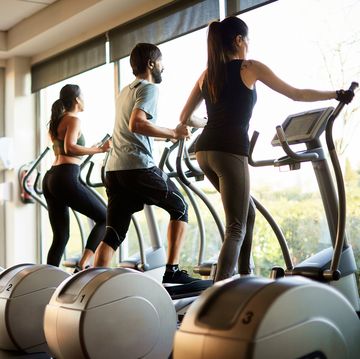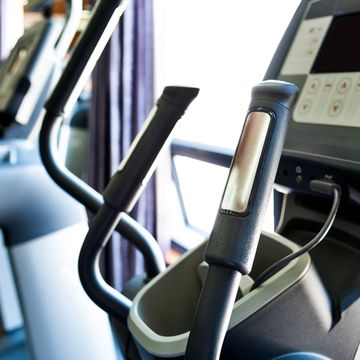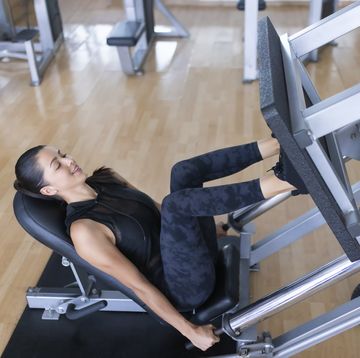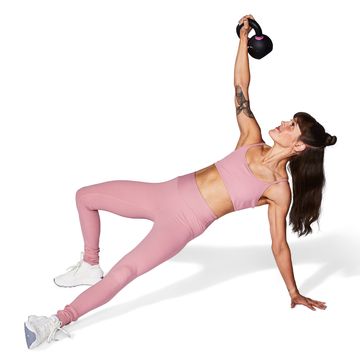At times, even the hardiest running souls want to avoid the great outdoors, especially in the winter when you're faced with freezing temperatures, spine-tingling winds and precipitation to dampen both your body and your spirits.
Thankfully, though, the are plenty of ways you can train indoors to keep your body moving, your mood in check and your running progress on track. Whether you're a new runner or a seasoned runner looking for safe, effective indoor alternatives to cancelled outdoor runs, the following workouts will help you train well when inclement weather – or a simple desire to stay indoors – stops you from stepping out the door.
Run on the treadmill
The most obvious substitute for an outdoor run is an indoor run on the treadmill, whether that's at the gym or on your own treadmill at home. But while this sounds easy enough, you'll first want to consider the differences between running on a rotating belt and pounding the trails and pavements.
For starters, running a set pace outdoors isn’t necessarily the same as running that same pace on the treadmill, so don't get too fixated on the numbers. 'Treadmills can be hit or miss on calibration for pace,' says Jenna-Caer Seefried, a triathlon and running coach based in Alberta, Canada. 'I’ve seen some treadmills be off by more than a minute per mile, and runners can either injure themselves from running too fast or not get the same benefits of the workout because they’re running too slow.'
That’s why Seefried suggests using pace data on the treadmill as just a guideline on how fast you're running. If you keep tabs on your heart rate data, take a look at the range you typically fall in during your outdoor runs. You can then use this to steer your treadmill runs, meaning you can dial up or down your speed accordingly to hit the same heart rate zone.
If you don’t track your heart rate, Seefried suggests paying attention to your perceived effort when running outdoors instead. Your perceived effort relates to how hard your run feels on a scale of one to 10 – this will naturally change depending on whether you do a long run, a tempo run or an interval run, for example. So, consider your training plan, the run you have scheduled for that day and the perceived effort that this run should entail. Then, play around with the settings on the treadmill until you can match that effort.
It's also worth noting that a treadmill locks you into a fixed incline and speed, which is something that pretty much never happens when you run outside. In some ways, this makes treadmill running easier than outdoor running, because you are not faced with obstacles such as unsavoury weather, tricky terrain and traffic – which could all be reasons for wanting to run indoors in the first place.
However, running on a treadmill can also feel like more of a challenge because it forces you to work at a fixed speed and gradient – without let up, and no matter how fatigued you get – unless you change the settings. By contrast, when you run outside, you speed up and slow down without even realising most of the time. Your pace may dip slightly when you get tired, then pick up again when you get a second wind.
Steve Stonehouse, a US running coach and Director of Education for STRIDE, an indoor running studio, recommends increasing the incline on an treadmill by at least 1-2% to better mimic the demands of running outdoors on flat ground. And if you ever feel bored while running on that belt, consider listening to music or a podcast – we can safely recommend the Runner's World UK Podcast as a starting point.
Choose another cardio workout
Bad weather offers a great opportunity to try some other low-impact forms of cardio exercise, like cycling on a turbo trainer, using an elliptical or doing some indoor rowing. With these cross training exercises, you’re still reaping the aerobic benefits of running – you’re just saving your body from the all impact of your feet pounding against the ground.
However, it takes a little know-how to translate your outdoor run to another indoor modality. In other words, a two-mile run doesn't perfectly translate to two miles worth of work on the bike or rowing machine. The effect of running at certain pace is also very different to the effect of cycling or rowing at that same pace.
Stonehouse recommends using time and intensity to guide you rather than distance or pace. So, if you had a two-mile tempo run on the schedule, think about how long that run would normally take you to complete. Spend that time on your cardio equipment of choice and try to match the intensity of that run. Once again, you can use your heart rate or perceived effort to ensure you stay on track and feel challenged in the same way that you would have done on an outdoor run.
Do a bodyweight HIIT workout
If you don’t have an indoor cardio machine to use, or can't access a gym, you can still get an effective cardio workout with high-intensity interval training (HIIT). This is especially true if you were otherwise planning to run intervals.
Using bodyweight exercises as the basis of your HIIT workout can help you build key muscle strength and endurance to support your running. 'Setting a solid foundation can make all the difference for resilience to muscle fatigue in the back half of your race, and HIIT is a time-effective way to [build that foundation],' says Seefried.
The following 18-minute HIIT workout incorporates core work and plyometric exercises. You’ll also activate your posterior chain – the muscles down the back of the body – and, thanks to the jump movements, train your body to handle impact, which can help to reduce your ground contact time and prevent a breakdown of form while running.
To do this workout, follow each set of bodyweight exercises in order. Perform each move for 20 seconds, working as quickly as you can without breaking form. Rest for 10 seconds between each exercise and round, and for one minute between each set.
Set 1
Complete two rounds of the following exercises:
- Squat
- Squat pulse
- Reverse lunge, hopping on the right leg
- Reverse lunge, hopping on the left leg
Set 2
Complete four rounds of the following exercises:
- Deadlift
- Heisman Shuffle – start in a standing position with slightly bent knees, then shuffle quickly to the left two times, lift your right knee high, then repeat for the other side
Set 3
Complete four rounds of the following exercises:
- Skaters
- Calf raise
Set 4
Complete two rounds of the following exercises:
- Plank with a straight right leg lift
- Squat jump
- Plank with a straight left leg lift
- Squat jump













